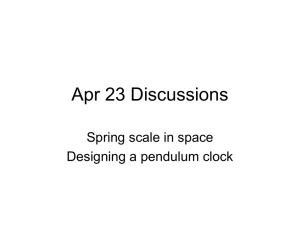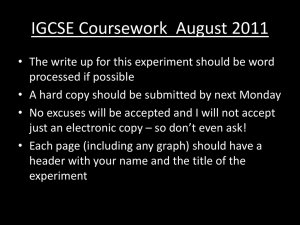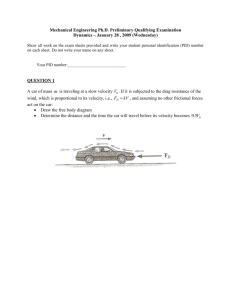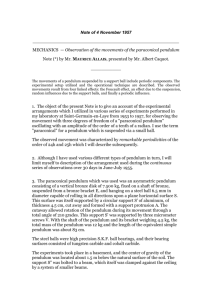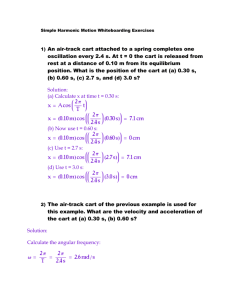Note of 25 November 1957 - Professor Maurice Allais
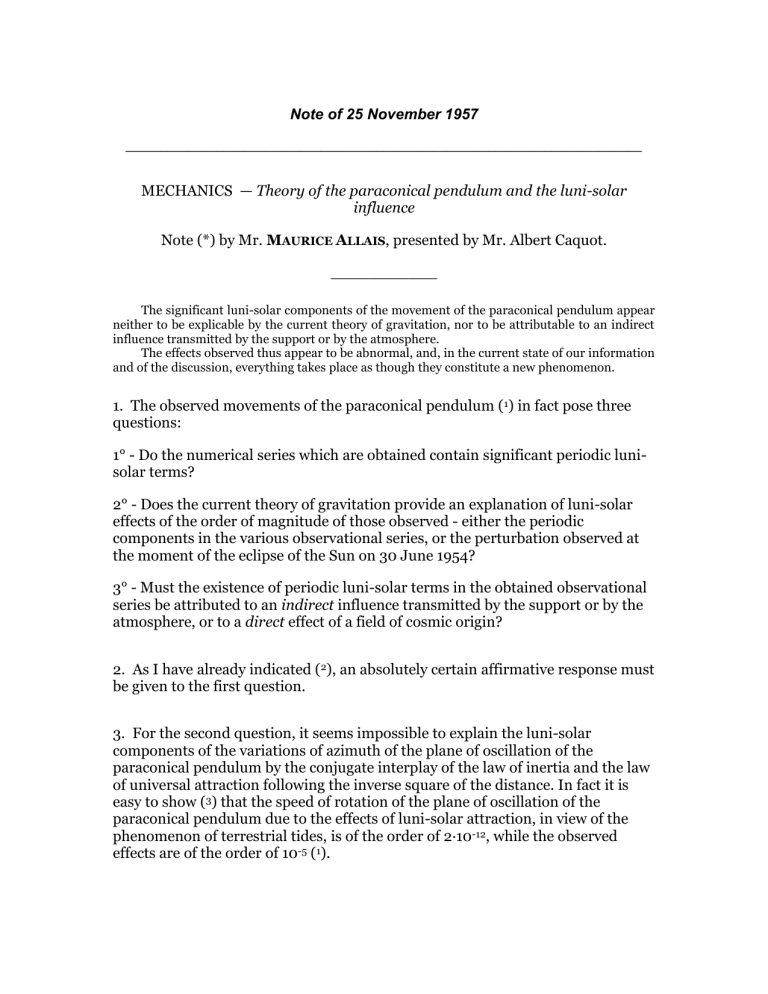
Note of 25 November 1957
__________________________________________________________________________
MECHANICS — Theory of the paraconical pendulum and the luni-solar
influence
Note (*) by Mr. M AURICE A LLAIS , presented by Mr. Albert Caquot.
___________
The significant luni-solar components of the movement of the paraconical pendulum appear neither to be explicable by the current theory of gravitation, nor to be attributable to an indirect influence transmitted by the support or by the atmosphere.
The effects observed thus appear to be abnormal, and, in the current state of our information and of the discussion, everything takes place as though they constitute a new phenomenon.
1. The observed movements of the paraconical pendulum ( 1 ) in fact pose three questions:
1° - Do the numerical series which are obtained contain significant periodic lunisolar terms?
2° - Does the current theory of gravitation provide an explanation of luni-solar effects of the order of magnitude of those observed - either the periodic components in the various observational series, or the perturbation observed at the moment of the eclipse of the Sun on 30 June 1954?
3° - Must the existence of periodic luni-solar terms in the obtained observational series be attributed to an indirect influence transmitted by the support or by the atmosphere, or to a direct effect of a field of cosmic origin?
2. As I have already indicated ( 2 ), an absolutely certain affirmative response must be given to the first question.
3. For the second question, it seems impossible to explain the luni-solar components of the variations of azimuth of the plane of oscillation of the paraconical pendulum by the conjugate interplay of the law of inertia and the law of universal attraction following the inverse square of the distance. In fact it is easy to show ( 3 ) that the speed of rotation of the plane of oscillation of the paraconical pendulum due to the effects of luni-solar attraction, in view of the phenomenon of terrestrial tides, is of the order of 2·10 -12 , while the observed effects are of the order of 10 -5 ( 1 ).
The extraordinary smallness of the calculated effects can be easily explained, if one takes account of the fact that, in order to obtain the effective gradient ƒ of the luni-solar attraction at a point on the surface of the soil with respect to the Earth, it is necessary to take the difference of the attractions at this point and at the center of the Earth. ƒ is of the order of 10-8. Moreover, the plane of oscillation of the pendulum can only turn under the influence of the luni-solar attraction because of the variations of this gradient around the point considered. It is accordingly necessary to consider the difference Δ ƒ between the value of ƒ at the average position of the pendulum and its value at a neighboring point. Δ ƒ is of the order of 10 -13 .
Furthermore, I see nothing in the current theory of gravitation which appears to be able to explain the perturbation (which presents itself as a screening phenomenon) observed during the eclipse of the Sun in 1954.
4. Finally, as concerns the third question, a priori, one could envisage as possible indirect explanations the following effects which have been observed: a. the numerous imperfections of the support arrangements (notably, imperfections of the support balls and of the bearing surfaces and mechanical anisotropy of the support); b. movements of air in the laboratory; c. terrestrial magnetism; d. variations of temperature or of pressure inside the laboratory or outside it; e. variations of the vertical; f. a dynamic thermal movement of the soil, transmitted by the building. At least in my opinion, for the reasons which follow, none of these explanations appear to me to be sustainable.
Causes a and b — The only systematic or random effects which these causes could entail could not appear as statistically significant in the harmonic analysis of the periods of 24h or 24h 50m. Moreover one must underline that, to the extent that the periodic components are linked to the existence of elliptic trajectories, because imperfections of the support favor the creation of such trajectories, they provide the advantage of permitting the observed phenomena to appear.
Causes c and d — As I have already indicated ( 1 ), the effect of the intervention of these causes would be a tight connection to the results of harmonic analysis, which is not observed.
Causes e and f — These are linked to variations of inclination of the bearing surface with respect to the field of weight. However, certain experiments which I have made (on the one hand a systematic series of releases in a given azimuth with the bearing surface being alternatively horizontal and inclined, and on the other hand a continuous series of doubly chained observations over 84h with the bearing surface being alternatively horizontal and inclined) show that the movement of the pendulum appears to be quite insensitive to variations of horizontality of the order of 17', i.e. of the order of 1,000". Moreover, the
deviation of the vertical under the influence of the classical thermal effect of 24h does not exceed 1", and also I have discovered that the horizontality of the bearing surface varies at most by 10" during a day of continuous observations. It thus appears impossible to maintain causes e and f.
Cause f. — It is sufficient to underline that, during the 14m which each elementary experiment lasts, any dynamic phenomenon whose period is at least several hours seems to me to be unable to act upon the movement of the pendulum in other than a static manner.
Causes c, d, e, and f. — It cannot be sufficiently underlined that, at least to my knowledge, no known geophysical phenomenon presents, over the period of one lunation, an average diurnal lunar effect, which both is much greater than the semi-diurnal lunar effect and also is of a similar order of magnitude to the diurnal solar effect. As a consequence, the causes c, d, e, and f seem to be to be eliminated.
5. In total, and in the current state of the discussion, it seems to me to be difficult to escape from the conclusion that everything takes place as though the observed effects are results of the direct effect of a field which cannot be explained by any known theory. In this state, therefore, these effects seem to me to constitute a new phenomenon.
(*) Session of 25 November 1957.
( 1 ) Proceedings, 245, 1957, pp. 1697, 1875, and 2001.
( 2 ) Proceedings, 245, 1957, pp. 1875 and 2001.
( 3 ) The use of a new parametric representation (I have represented the movement of the pendulum by the parameters m=-sin θ sin ψ, n=sin θ cos ψ, u=φ+ψ, where θ, φ, and
ψ are Euler's parameters), associated with the method of convergent ?? integration of the equations of elliptic motion by the method of variation of Lagrange's constants, has allowed me to calculate, to the first approximation, all the interesting perturbations of the movement of the paraconical pendulum rapidly and without difficulty, provided that the amplitude of the oscillation remains relatively small and does not exceed a sixth of a radian. Taking account of the terrestrial tides, this calculation gives, for the influence of the Moon on the movement of the plane of oscillation of the conical pendulum to which the paraconical pendulum reduces in the first approximation, two effects:
a, a direct effect represented by the equation:
b, an indirect effect represented by the equations: where: Φ is the azimuth of the plane of oscillation reckoned from the South in the direct sense; A l
is the azimuth of the Moon; α and β are the major and minor axes of the ellipse
of oscillation (in radians); T is the period of oscillation in seconds;
K l
= (3/2)(1+k-h)C l sin 2 φ l
; h=0.465 and k=0.190 (Love numbers); φ t t
2 /M t d l
3 =0.857·10 -13 U.C.G.S.; g is the
is the radius of the Earth; d l
is the distance of the Moon at zenith; C gravitational acceleration; r the Moon; and M t l
=gM l r
and M l valid for the action of the Sun (for which C l
is the distance from the Earth to are the masses of the Earth and the Moon. A similar formula is
The application of this formula shows that in the case of our pendulum for which
T=1.83, α < 0.11, β < 0.006, and Δt=840 sec, the direct effect is about 130 times less than the indirect effect, and that for the latter: s
=0.896·10 -13 ).
|Φ i
'| < 1.8·10 -13 .
(Extract of the Proceedings of the Sessions of the Academy of Sciences, t. 245, pp. 2170-2173, session of 16 December 1957.)



